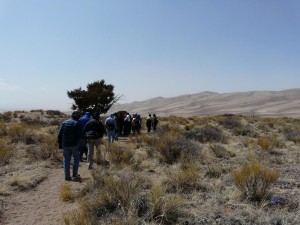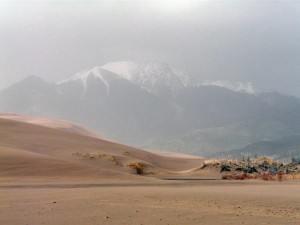 Last week the Sandhill Cranes migration brought Walking Mountains outdoor enthusiasts to the San Luis Valley near Alamosa, Colorado. On this trip we witnessed several amazing feats of nature. One of these was the dunes at Great Sand Dunes National Park. Rising up to 750 feet above the valley floor, the sight of the dunes tucked up against the Sangre de Cristos is almost surreal.
Last week the Sandhill Cranes migration brought Walking Mountains outdoor enthusiasts to the San Luis Valley near Alamosa, Colorado. On this trip we witnessed several amazing feats of nature. One of these was the dunes at Great Sand Dunes National Park. Rising up to 750 feet above the valley floor, the sight of the dunes tucked up against the Sangre de Cristos is almost surreal.
Although there is no clear date, researchers believe the dunes could be up to 440,000 years old. They are unique in that they've changed very little in at least the last 130 years (for which we have photographic comparisons). Geologists believe that the valley was once covered by a lake many thousands of years ago. The lakes eventually receded with climate changes leaving a significant sand sheet on the valley floor. Over time, predominant southwest winds moved the sand up against a low curve in the Sangre de Cristo Range. Storm winds blow the opposite direction creating the vertical nature of these dunes (the highest in the US). These opposing wind directions balance each other out over time. The main dune field is moist beneath the thin layer of dry surface sand which also lends to the stability of this system. In windstorms, the top few inches of sand blows around, and the moist sand remains largely in place.
The the day we visited the dunes the winds were blowing up to 35 mph. We persevered and set out for a tour with Ranger Libbie against all odds. Although sandblasted and wind whipped, we thoroughly enjoyed our foray onto the dunes. Libbie's backpack seemed to be a never-ending void filled with educational exhibits and tools. Harard Peak provided a beautiful backdrop as we learned about local vegetation, animal life, geology and more. The geology was particularly interesting - we saw samples of fulgarite which are the resulting formations from lighting hitting the sand, a demonstration about magnetite - the magnetic bits of iron oxide in black sand, and we learned about epidote - the beautiful green colored local rocks found throughout the park. Libbie even packed in samples of insects that live on the dunes and a kangaroo rat which had seen some better days. We also witnessed remnants of a large wildfire that ravaged parts of the park a few years prior. Caked ash remains part of the seasonally dry riverbed in Medano Creek.
We trekked out and back a few miles and then headed on to the park's visitor center. All in all it was a fantastic day and a super learning experience. If you've never visited this area of Colorado, consider taking a trip. It's only 3-4 hours from Denver and well worth the spectacular sights.







